Strategic HRM Approach at Air New Zealand: A Comprehensive Analysis
VerifiedAdded on 2022/11/13
|19
|4369
|149
Report
AI Summary
This report provides a comprehensive analysis of the strategic human resource management (HRM) approaches implemented by Air New Zealand. The analysis begins with an examination of Ulrich's model and how Air New Zealand utilizes it, focusing on the roles of change agent and employee champion. The report then delves into the organization's HRM strategies within the context of its value chain, specifically in relation to technological development, operations, and marketing and sales. Furthermore, the report explores two key models of strategic HRM: the Business Partner model and the Performance Culture model, discussing their advantages, disadvantages, and their application within the context of Air New Zealand. Finally, the report highlights the benefits of designing and implementing an effective HRM strategy at Air New Zealand, including improved employee performance, enhanced communication, and increased employee motivation, ultimately contributing to organizational success and improved customer satisfaction.
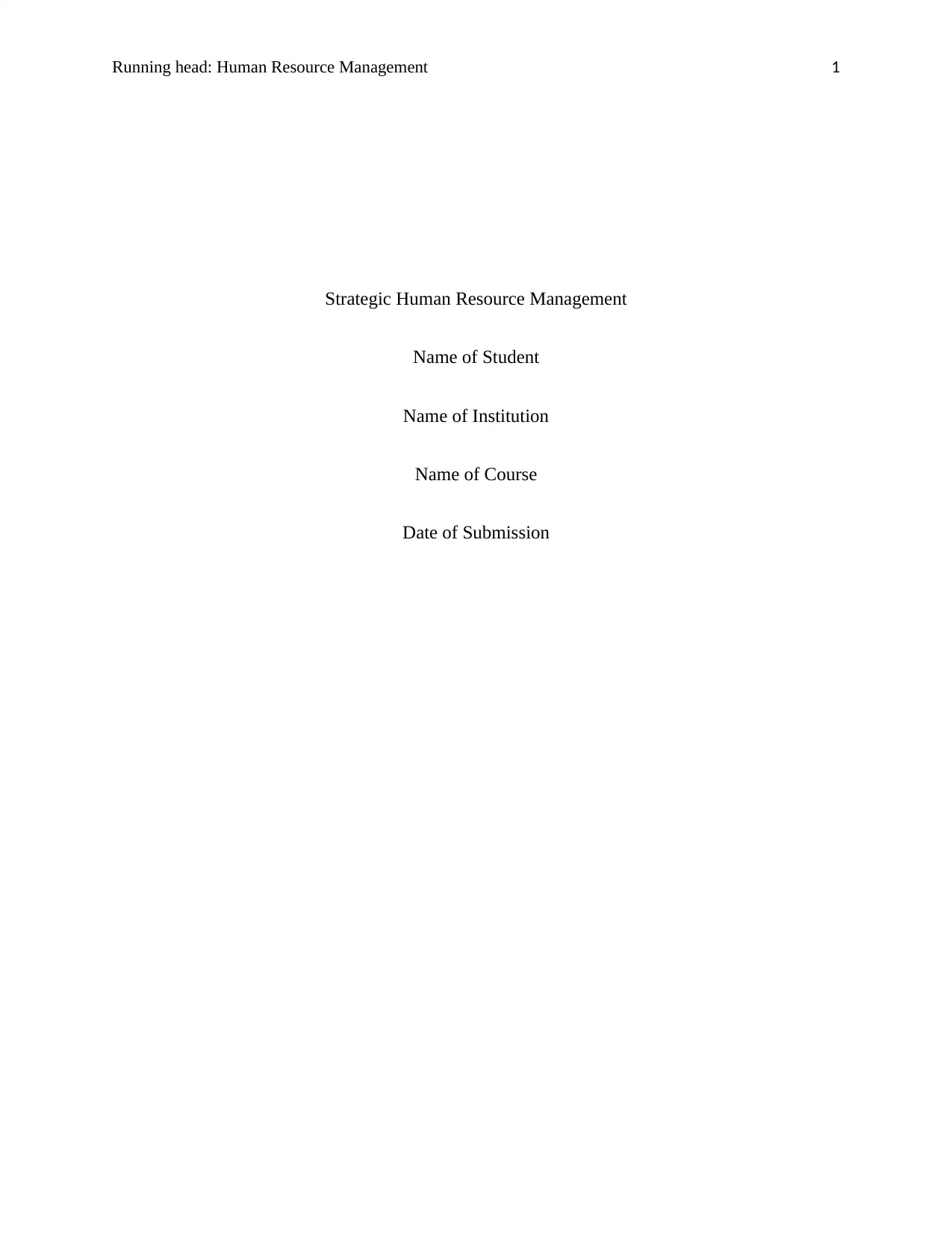
Running head: Human Resource Management 1
Strategic Human Resource Management
Name of Student
Name of Institution
Name of Course
Date of Submission
Strategic Human Resource Management
Name of Student
Name of Institution
Name of Course
Date of Submission
Paraphrase This Document
Need a fresh take? Get an instant paraphrase of this document with our AI Paraphraser
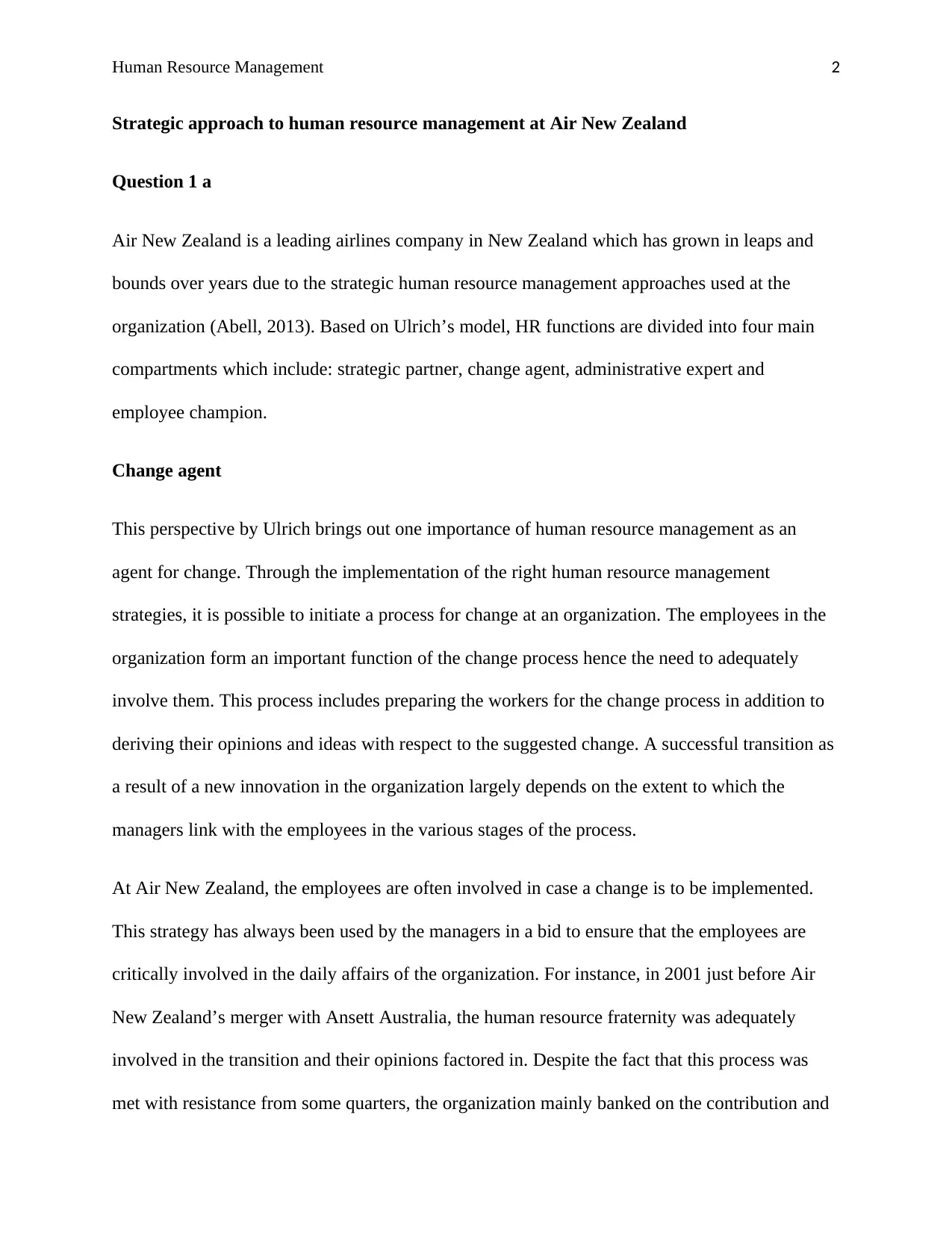
Human Resource Management 2
Strategic approach to human resource management at Air New Zealand
Question 1 a
Air New Zealand is a leading airlines company in New Zealand which has grown in leaps and
bounds over years due to the strategic human resource management approaches used at the
organization (Abell, 2013). Based on Ulrich’s model, HR functions are divided into four main
compartments which include: strategic partner, change agent, administrative expert and
employee champion.
Change agent
This perspective by Ulrich brings out one importance of human resource management as an
agent for change. Through the implementation of the right human resource management
strategies, it is possible to initiate a process for change at an organization. The employees in the
organization form an important function of the change process hence the need to adequately
involve them. This process includes preparing the workers for the change process in addition to
deriving their opinions and ideas with respect to the suggested change. A successful transition as
a result of a new innovation in the organization largely depends on the extent to which the
managers link with the employees in the various stages of the process.
At Air New Zealand, the employees are often involved in case a change is to be implemented.
This strategy has always been used by the managers in a bid to ensure that the employees are
critically involved in the daily affairs of the organization. For instance, in 2001 just before Air
New Zealand’s merger with Ansett Australia, the human resource fraternity was adequately
involved in the transition and their opinions factored in. Despite the fact that this process was
met with resistance from some quarters, the organization mainly banked on the contribution and
Strategic approach to human resource management at Air New Zealand
Question 1 a
Air New Zealand is a leading airlines company in New Zealand which has grown in leaps and
bounds over years due to the strategic human resource management approaches used at the
organization (Abell, 2013). Based on Ulrich’s model, HR functions are divided into four main
compartments which include: strategic partner, change agent, administrative expert and
employee champion.
Change agent
This perspective by Ulrich brings out one importance of human resource management as an
agent for change. Through the implementation of the right human resource management
strategies, it is possible to initiate a process for change at an organization. The employees in the
organization form an important function of the change process hence the need to adequately
involve them. This process includes preparing the workers for the change process in addition to
deriving their opinions and ideas with respect to the suggested change. A successful transition as
a result of a new innovation in the organization largely depends on the extent to which the
managers link with the employees in the various stages of the process.
At Air New Zealand, the employees are often involved in case a change is to be implemented.
This strategy has always been used by the managers in a bid to ensure that the employees are
critically involved in the daily affairs of the organization. For instance, in 2001 just before Air
New Zealand’s merger with Ansett Australia, the human resource fraternity was adequately
involved in the transition and their opinions factored in. Despite the fact that this process was
met with resistance from some quarters, the organization mainly banked on the contribution and

Human Resource Management 3
support from the employees to see the successful implementation of the change (Armstrong &
Baron, 2012). In a nut shell, the organization’s HRM strategy involves including the employees
in critical decision making processes especially those that involve change in order to incorporate
them as core agents in the process of change.
Employee champion
Air New Zealand has put in place the right strategies to ensure that the rights and privileges
meant for employees are upheld at any given time (Berg & Huebner, 2011). The organization
sees the workers as valuable assets within the organization hence constantly coming up with
measures to ensure that they stay not only motivated but also competent in their areas of
responsibility. Between 2010 and 2015, the organization has invested on employee
empowerment through training and exposure. The strategy in this case involves taking the
employees through sessions aimed at sharpening their skills and hence ensuring quality service
delivery. The organization carries out annual and bi annual seminars in which employees are
taken through interactive, informative and educative sessions all aimed at improving competence
and awareness. Furthermore, Air New Zealand has a stable reward scheme. In 2017 during one
of its annual meetings, the organization recognized and awarded the best performers in various
departments. These strategies are aimed at ensuring the well being of the employees, improving
their commitment to the organizational goals and eventually improving the overall output at the
organization.
support from the employees to see the successful implementation of the change (Armstrong &
Baron, 2012). In a nut shell, the organization’s HRM strategy involves including the employees
in critical decision making processes especially those that involve change in order to incorporate
them as core agents in the process of change.
Employee champion
Air New Zealand has put in place the right strategies to ensure that the rights and privileges
meant for employees are upheld at any given time (Berg & Huebner, 2011). The organization
sees the workers as valuable assets within the organization hence constantly coming up with
measures to ensure that they stay not only motivated but also competent in their areas of
responsibility. Between 2010 and 2015, the organization has invested on employee
empowerment through training and exposure. The strategy in this case involves taking the
employees through sessions aimed at sharpening their skills and hence ensuring quality service
delivery. The organization carries out annual and bi annual seminars in which employees are
taken through interactive, informative and educative sessions all aimed at improving competence
and awareness. Furthermore, Air New Zealand has a stable reward scheme. In 2017 during one
of its annual meetings, the organization recognized and awarded the best performers in various
departments. These strategies are aimed at ensuring the well being of the employees, improving
their commitment to the organizational goals and eventually improving the overall output at the
organization.
⊘ This is a preview!⊘
Do you want full access?
Subscribe today to unlock all pages.

Trusted by 1+ million students worldwide
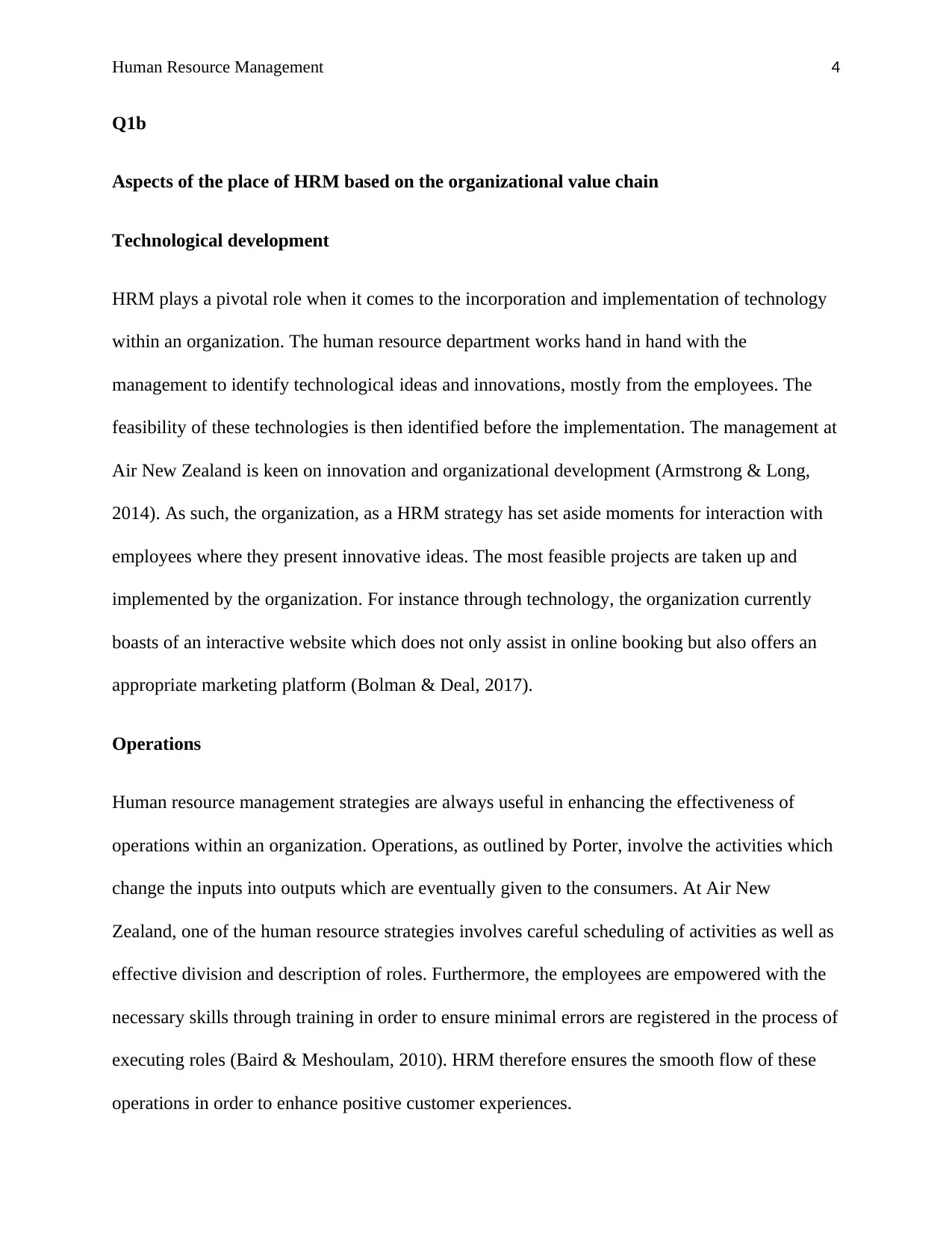
Human Resource Management 4
Q1b
Aspects of the place of HRM based on the organizational value chain
Technological development
HRM plays a pivotal role when it comes to the incorporation and implementation of technology
within an organization. The human resource department works hand in hand with the
management to identify technological ideas and innovations, mostly from the employees. The
feasibility of these technologies is then identified before the implementation. The management at
Air New Zealand is keen on innovation and organizational development (Armstrong & Long,
2014). As such, the organization, as a HRM strategy has set aside moments for interaction with
employees where they present innovative ideas. The most feasible projects are taken up and
implemented by the organization. For instance through technology, the organization currently
boasts of an interactive website which does not only assist in online booking but also offers an
appropriate marketing platform (Bolman & Deal, 2017).
Operations
Human resource management strategies are always useful in enhancing the effectiveness of
operations within an organization. Operations, as outlined by Porter, involve the activities which
change the inputs into outputs which are eventually given to the consumers. At Air New
Zealand, one of the human resource strategies involves careful scheduling of activities as well as
effective division and description of roles. Furthermore, the employees are empowered with the
necessary skills through training in order to ensure minimal errors are registered in the process of
executing roles (Baird & Meshoulam, 2010). HRM therefore ensures the smooth flow of these
operations in order to enhance positive customer experiences.
Q1b
Aspects of the place of HRM based on the organizational value chain
Technological development
HRM plays a pivotal role when it comes to the incorporation and implementation of technology
within an organization. The human resource department works hand in hand with the
management to identify technological ideas and innovations, mostly from the employees. The
feasibility of these technologies is then identified before the implementation. The management at
Air New Zealand is keen on innovation and organizational development (Armstrong & Long,
2014). As such, the organization, as a HRM strategy has set aside moments for interaction with
employees where they present innovative ideas. The most feasible projects are taken up and
implemented by the organization. For instance through technology, the organization currently
boasts of an interactive website which does not only assist in online booking but also offers an
appropriate marketing platform (Bolman & Deal, 2017).
Operations
Human resource management strategies are always useful in enhancing the effectiveness of
operations within an organization. Operations, as outlined by Porter, involve the activities which
change the inputs into outputs which are eventually given to the consumers. At Air New
Zealand, one of the human resource strategies involves careful scheduling of activities as well as
effective division and description of roles. Furthermore, the employees are empowered with the
necessary skills through training in order to ensure minimal errors are registered in the process of
executing roles (Baird & Meshoulam, 2010). HRM therefore ensures the smooth flow of these
operations in order to enhance positive customer experiences.
Paraphrase This Document
Need a fresh take? Get an instant paraphrase of this document with our AI Paraphraser

Human Resource Management 5
Marketing and sales
Successful human resource management strategies do not only enhance the output within the
organization but equally supports the stability of the brand. The employees at Air New Zealand
are all considered as brand ambassadors. This tag ought to be maintained in every area of
responsibility. The workers therefore play a part when it comes to marketing the airlines through
the provision of high quality services to the consumers (Barney, 2011). The treatment of the
customers by the crew for instance, determines whether they would come for the services again.
The organization has effectively involved the employees in enhancing marketing and sales which
explains an increase in number of passengers by 5% between 2015 and 2016. The organization’s
market dominance especially in the local arena has gradually improved due to the successful
implementation of human resource management strategies which enhance marketing and sales.
Marketing and sales
Successful human resource management strategies do not only enhance the output within the
organization but equally supports the stability of the brand. The employees at Air New Zealand
are all considered as brand ambassadors. This tag ought to be maintained in every area of
responsibility. The workers therefore play a part when it comes to marketing the airlines through
the provision of high quality services to the consumers (Barney, 2011). The treatment of the
customers by the crew for instance, determines whether they would come for the services again.
The organization has effectively involved the employees in enhancing marketing and sales which
explains an increase in number of passengers by 5% between 2015 and 2016. The organization’s
market dominance especially in the local arena has gradually improved due to the successful
implementation of human resource management strategies which enhance marketing and sales.

Human Resource Management 6
Question 2
Models of Strategic Human Resource management
1. Business Partner model
The dynamic nature of the corporate world indicates that the roles of HR are changing every
time. Most of the traditional approaches involved manual hands on approach; however, the rise
in technology has given room for automated HR roles hence making it a crucial element in
management. Most companies therefore see HR as a key business partner hence the need for
alignment of HR goals and that of the organization. The core strategy at Air New Zealand is to
enhance customer satisfaction through the provision of high quality services, use of sleek and
safe flights and competent personnel (Ashforth & Kreiner, 2009). Based on this model, the
Airlines may need to consider aligning its HR strategies to the organizational goal. The aim of
the organization is to ensure a stable base of clients and an improvement in the number of
passengers every year. The HR strategy which can be used to achieve this include training of
workers to improve competency and skills, compensation which enhances motivation as well as
hiring of qualified personnel to work as the cabin crew. The HRM outcomes lead to improved
performance within the organization which increases the market grip (Boxall, 2009). This would
culminate in better financial performance since the increase in number of passenger annually
leads to improved return on investment.
Advantages
One advantage of this model is that it gives the organization a competitive advantage over the
others. The model enhances internal performance which generally improves the quality of output
Question 2
Models of Strategic Human Resource management
1. Business Partner model
The dynamic nature of the corporate world indicates that the roles of HR are changing every
time. Most of the traditional approaches involved manual hands on approach; however, the rise
in technology has given room for automated HR roles hence making it a crucial element in
management. Most companies therefore see HR as a key business partner hence the need for
alignment of HR goals and that of the organization. The core strategy at Air New Zealand is to
enhance customer satisfaction through the provision of high quality services, use of sleek and
safe flights and competent personnel (Ashforth & Kreiner, 2009). Based on this model, the
Airlines may need to consider aligning its HR strategies to the organizational goal. The aim of
the organization is to ensure a stable base of clients and an improvement in the number of
passengers every year. The HR strategy which can be used to achieve this include training of
workers to improve competency and skills, compensation which enhances motivation as well as
hiring of qualified personnel to work as the cabin crew. The HRM outcomes lead to improved
performance within the organization which increases the market grip (Boxall, 2009). This would
culminate in better financial performance since the increase in number of passenger annually
leads to improved return on investment.
Advantages
One advantage of this model is that it gives the organization a competitive advantage over the
others. The model enhances internal performance which generally improves the quality of output
⊘ This is a preview!⊘
Do you want full access?
Subscribe today to unlock all pages.

Trusted by 1+ million students worldwide

Human Resource Management 7
hence culminating in positive consumer experiences. This improves sales and hence returns on
investment.
Secondly, the model enhances communication within the organization since aligning the
strategies involves a network of interactions between various individuals (Christensen, Hall,
Dillon & Duncan, 2016). Interactions enhance the growth of positive relations which in turn
improves communication.
Thirdly, the model is essential in helping the organization to understand the needs of the
consumers. The strategies can therefore be specific and objectively aimed at addressing the needs
of the consumers. Through company customer relations, it is possible to identify the loopholes
which can then be filled to enhance better outcomes.
Disadvantages
Some of the components of the model such as hiring and training my involve high cost
implications on the organization. The organization may at times strain while implementing these
strategies especially when they require many resources
The components of the model also require a lot of time to implement. This becomes a setback
especially when speedy outcomes are needed (Boxall & Purcell, 2013). The model can only be
effective in situations where problems are solved through the implementation of long term
projects.
hence culminating in positive consumer experiences. This improves sales and hence returns on
investment.
Secondly, the model enhances communication within the organization since aligning the
strategies involves a network of interactions between various individuals (Christensen, Hall,
Dillon & Duncan, 2016). Interactions enhance the growth of positive relations which in turn
improves communication.
Thirdly, the model is essential in helping the organization to understand the needs of the
consumers. The strategies can therefore be specific and objectively aimed at addressing the needs
of the consumers. Through company customer relations, it is possible to identify the loopholes
which can then be filled to enhance better outcomes.
Disadvantages
Some of the components of the model such as hiring and training my involve high cost
implications on the organization. The organization may at times strain while implementing these
strategies especially when they require many resources
The components of the model also require a lot of time to implement. This becomes a setback
especially when speedy outcomes are needed (Boxall & Purcell, 2013). The model can only be
effective in situations where problems are solved through the implementation of long term
projects.
Paraphrase This Document
Need a fresh take? Get an instant paraphrase of this document with our AI Paraphraser
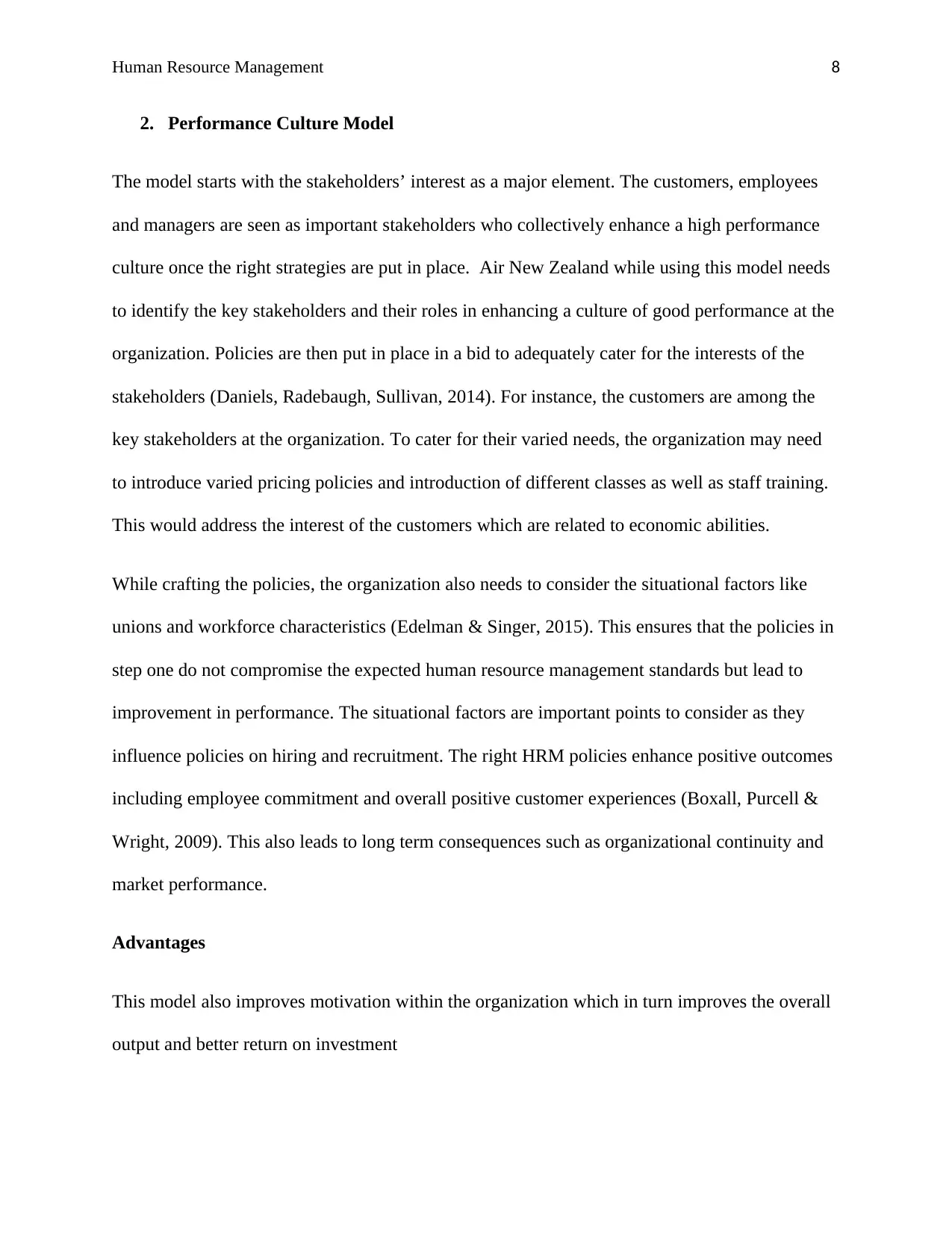
Human Resource Management 8
2. Performance Culture Model
The model starts with the stakeholders’ interest as a major element. The customers, employees
and managers are seen as important stakeholders who collectively enhance a high performance
culture once the right strategies are put in place. Air New Zealand while using this model needs
to identify the key stakeholders and their roles in enhancing a culture of good performance at the
organization. Policies are then put in place in a bid to adequately cater for the interests of the
stakeholders (Daniels, Radebaugh, Sullivan, 2014). For instance, the customers are among the
key stakeholders at the organization. To cater for their varied needs, the organization may need
to introduce varied pricing policies and introduction of different classes as well as staff training.
This would address the interest of the customers which are related to economic abilities.
While crafting the policies, the organization also needs to consider the situational factors like
unions and workforce characteristics (Edelman & Singer, 2015). This ensures that the policies in
step one do not compromise the expected human resource management standards but lead to
improvement in performance. The situational factors are important points to consider as they
influence policies on hiring and recruitment. The right HRM policies enhance positive outcomes
including employee commitment and overall positive customer experiences (Boxall, Purcell &
Wright, 2009). This also leads to long term consequences such as organizational continuity and
market performance.
Advantages
This model also improves motivation within the organization which in turn improves the overall
output and better return on investment
2. Performance Culture Model
The model starts with the stakeholders’ interest as a major element. The customers, employees
and managers are seen as important stakeholders who collectively enhance a high performance
culture once the right strategies are put in place. Air New Zealand while using this model needs
to identify the key stakeholders and their roles in enhancing a culture of good performance at the
organization. Policies are then put in place in a bid to adequately cater for the interests of the
stakeholders (Daniels, Radebaugh, Sullivan, 2014). For instance, the customers are among the
key stakeholders at the organization. To cater for their varied needs, the organization may need
to introduce varied pricing policies and introduction of different classes as well as staff training.
This would address the interest of the customers which are related to economic abilities.
While crafting the policies, the organization also needs to consider the situational factors like
unions and workforce characteristics (Edelman & Singer, 2015). This ensures that the policies in
step one do not compromise the expected human resource management standards but lead to
improvement in performance. The situational factors are important points to consider as they
influence policies on hiring and recruitment. The right HRM policies enhance positive outcomes
including employee commitment and overall positive customer experiences (Boxall, Purcell &
Wright, 2009). This also leads to long term consequences such as organizational continuity and
market performance.
Advantages
This model also improves motivation within the organization which in turn improves the overall
output and better return on investment
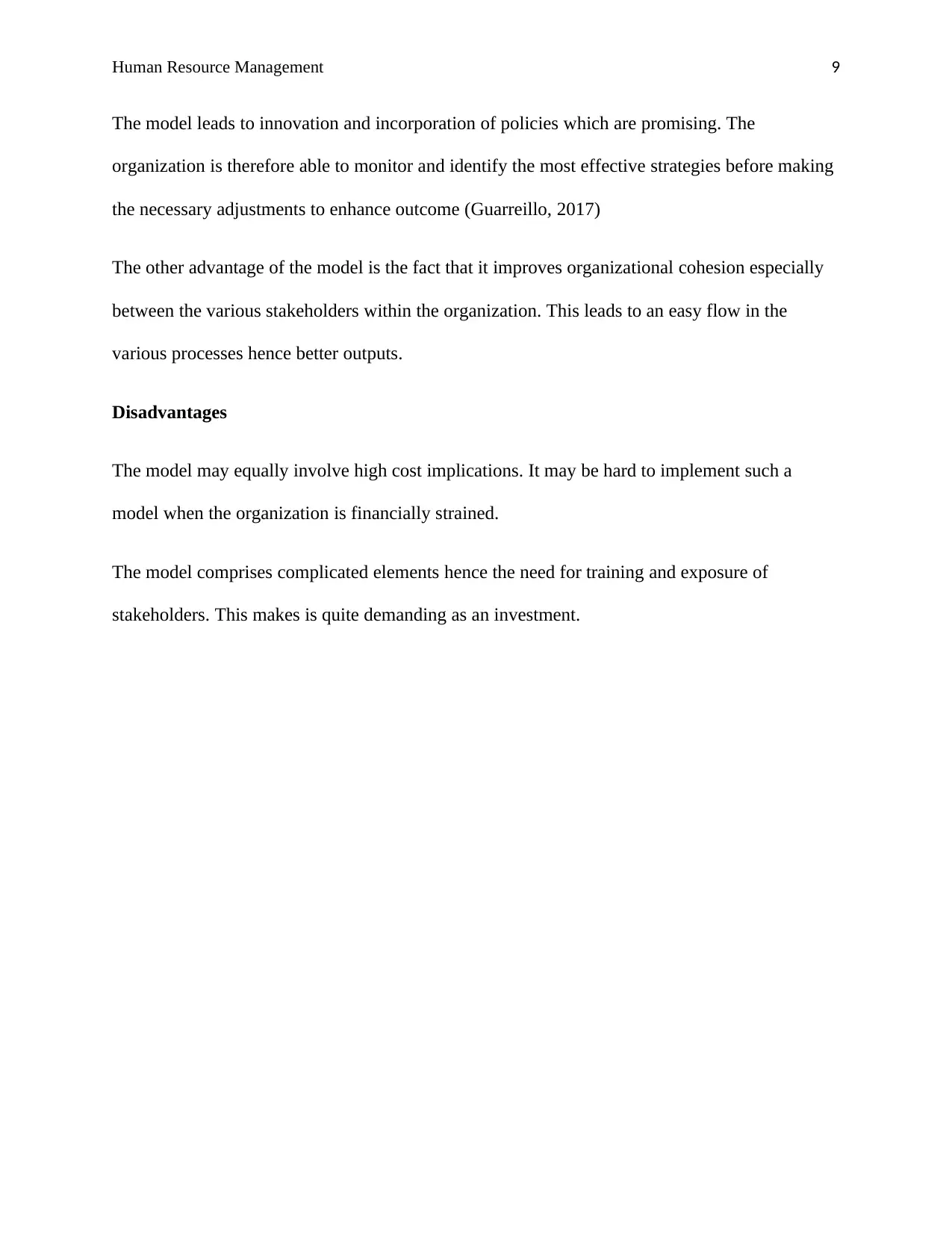
Human Resource Management 9
The model leads to innovation and incorporation of policies which are promising. The
organization is therefore able to monitor and identify the most effective strategies before making
the necessary adjustments to enhance outcome (Guarreillo, 2017)
The other advantage of the model is the fact that it improves organizational cohesion especially
between the various stakeholders within the organization. This leads to an easy flow in the
various processes hence better outputs.
Disadvantages
The model may equally involve high cost implications. It may be hard to implement such a
model when the organization is financially strained.
The model comprises complicated elements hence the need for training and exposure of
stakeholders. This makes is quite demanding as an investment.
The model leads to innovation and incorporation of policies which are promising. The
organization is therefore able to monitor and identify the most effective strategies before making
the necessary adjustments to enhance outcome (Guarreillo, 2017)
The other advantage of the model is the fact that it improves organizational cohesion especially
between the various stakeholders within the organization. This leads to an easy flow in the
various processes hence better outputs.
Disadvantages
The model may equally involve high cost implications. It may be hard to implement such a
model when the organization is financially strained.
The model comprises complicated elements hence the need for training and exposure of
stakeholders. This makes is quite demanding as an investment.
⊘ This is a preview!⊘
Do you want full access?
Subscribe today to unlock all pages.

Trusted by 1+ million students worldwide
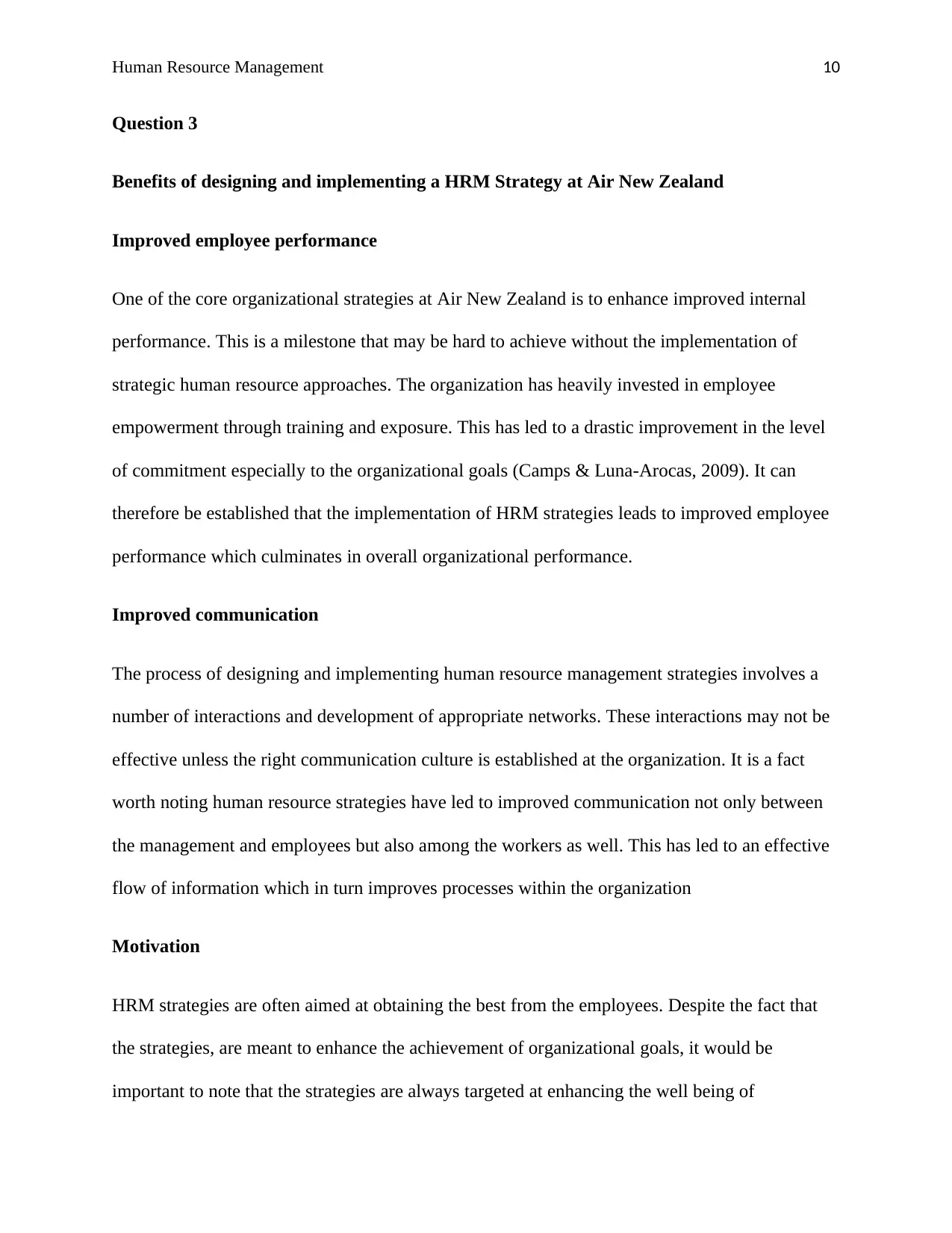
Human Resource Management 10
Question 3
Benefits of designing and implementing a HRM Strategy at Air New Zealand
Improved employee performance
One of the core organizational strategies at Air New Zealand is to enhance improved internal
performance. This is a milestone that may be hard to achieve without the implementation of
strategic human resource approaches. The organization has heavily invested in employee
empowerment through training and exposure. This has led to a drastic improvement in the level
of commitment especially to the organizational goals (Camps & Luna-Arocas, 2009). It can
therefore be established that the implementation of HRM strategies leads to improved employee
performance which culminates in overall organizational performance.
Improved communication
The process of designing and implementing human resource management strategies involves a
number of interactions and development of appropriate networks. These interactions may not be
effective unless the right communication culture is established at the organization. It is a fact
worth noting human resource strategies have led to improved communication not only between
the management and employees but also among the workers as well. This has led to an effective
flow of information which in turn improves processes within the organization
Motivation
HRM strategies are often aimed at obtaining the best from the employees. Despite the fact that
the strategies, are meant to enhance the achievement of organizational goals, it would be
important to note that the strategies are always targeted at enhancing the well being of
Question 3
Benefits of designing and implementing a HRM Strategy at Air New Zealand
Improved employee performance
One of the core organizational strategies at Air New Zealand is to enhance improved internal
performance. This is a milestone that may be hard to achieve without the implementation of
strategic human resource approaches. The organization has heavily invested in employee
empowerment through training and exposure. This has led to a drastic improvement in the level
of commitment especially to the organizational goals (Camps & Luna-Arocas, 2009). It can
therefore be established that the implementation of HRM strategies leads to improved employee
performance which culminates in overall organizational performance.
Improved communication
The process of designing and implementing human resource management strategies involves a
number of interactions and development of appropriate networks. These interactions may not be
effective unless the right communication culture is established at the organization. It is a fact
worth noting human resource strategies have led to improved communication not only between
the management and employees but also among the workers as well. This has led to an effective
flow of information which in turn improves processes within the organization
Motivation
HRM strategies are often aimed at obtaining the best from the employees. Despite the fact that
the strategies, are meant to enhance the achievement of organizational goals, it would be
important to note that the strategies are always targeted at enhancing the well being of
Paraphrase This Document
Need a fresh take? Get an instant paraphrase of this document with our AI Paraphraser
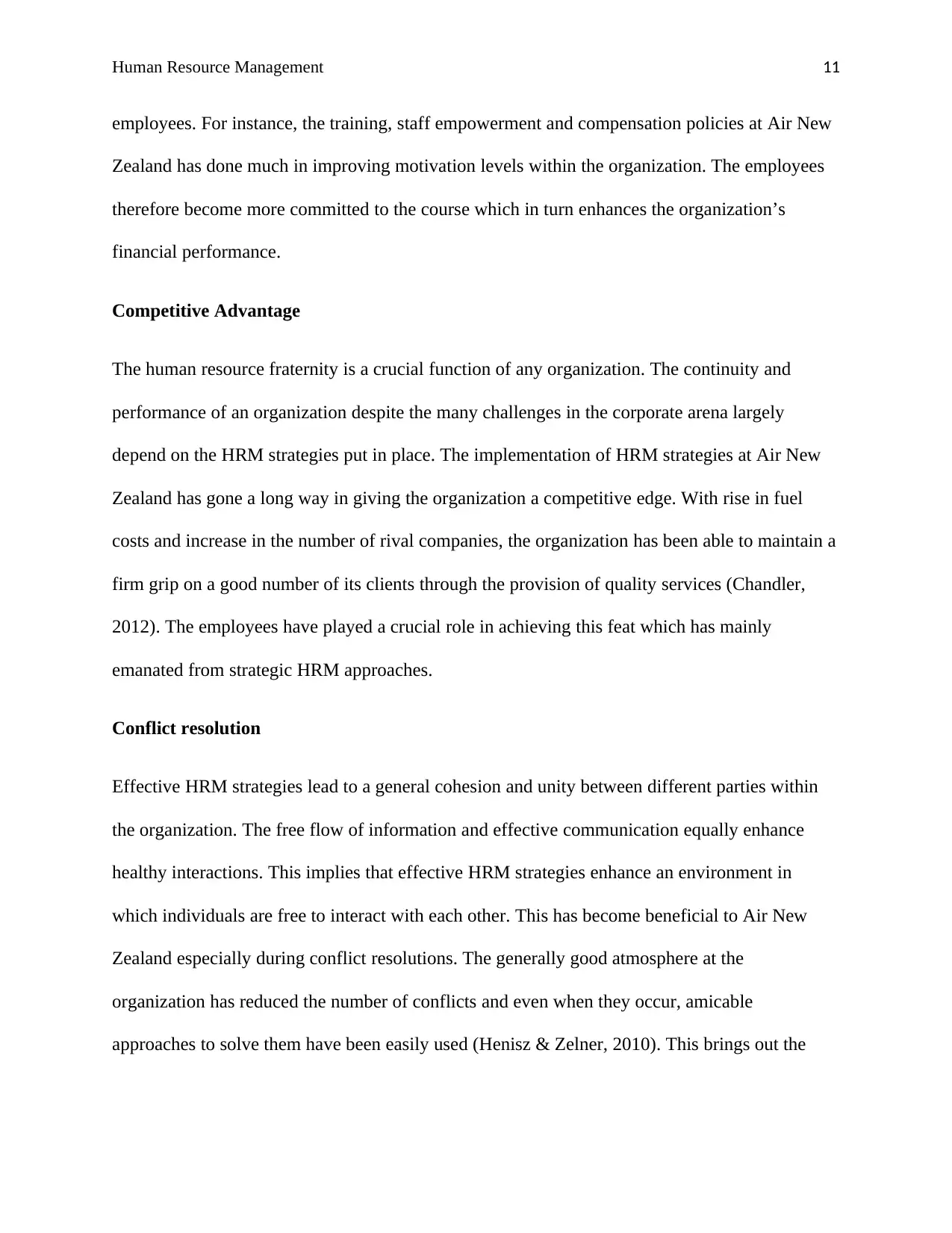
Human Resource Management 11
employees. For instance, the training, staff empowerment and compensation policies at Air New
Zealand has done much in improving motivation levels within the organization. The employees
therefore become more committed to the course which in turn enhances the organization’s
financial performance.
Competitive Advantage
The human resource fraternity is a crucial function of any organization. The continuity and
performance of an organization despite the many challenges in the corporate arena largely
depend on the HRM strategies put in place. The implementation of HRM strategies at Air New
Zealand has gone a long way in giving the organization a competitive edge. With rise in fuel
costs and increase in the number of rival companies, the organization has been able to maintain a
firm grip on a good number of its clients through the provision of quality services (Chandler,
2012). The employees have played a crucial role in achieving this feat which has mainly
emanated from strategic HRM approaches.
Conflict resolution
Effective HRM strategies lead to a general cohesion and unity between different parties within
the organization. The free flow of information and effective communication equally enhance
healthy interactions. This implies that effective HRM strategies enhance an environment in
which individuals are free to interact with each other. This has become beneficial to Air New
Zealand especially during conflict resolutions. The generally good atmosphere at the
organization has reduced the number of conflicts and even when they occur, amicable
approaches to solve them have been easily used (Henisz & Zelner, 2010). This brings out the
employees. For instance, the training, staff empowerment and compensation policies at Air New
Zealand has done much in improving motivation levels within the organization. The employees
therefore become more committed to the course which in turn enhances the organization’s
financial performance.
Competitive Advantage
The human resource fraternity is a crucial function of any organization. The continuity and
performance of an organization despite the many challenges in the corporate arena largely
depend on the HRM strategies put in place. The implementation of HRM strategies at Air New
Zealand has gone a long way in giving the organization a competitive edge. With rise in fuel
costs and increase in the number of rival companies, the organization has been able to maintain a
firm grip on a good number of its clients through the provision of quality services (Chandler,
2012). The employees have played a crucial role in achieving this feat which has mainly
emanated from strategic HRM approaches.
Conflict resolution
Effective HRM strategies lead to a general cohesion and unity between different parties within
the organization. The free flow of information and effective communication equally enhance
healthy interactions. This implies that effective HRM strategies enhance an environment in
which individuals are free to interact with each other. This has become beneficial to Air New
Zealand especially during conflict resolutions. The generally good atmosphere at the
organization has reduced the number of conflicts and even when they occur, amicable
approaches to solve them have been easily used (Henisz & Zelner, 2010). This brings out the

Human Resource Management 12
direct relationship between proper human resource management strategies and conflict resolution
within an organization.
Question 4
Evaluating the alignment of Air New Zealand’s corporate strategy with the HR strategies
Vertical integration
Vertical integration sees an organization take control of more than one level of the supply chain.
This allows the organization to easily monitor the effectiveness of aligning the HR strategies to
the organization’s corporate strategy.
One aspect of vertical integration is the fact that the company owns the supply chain. Each
department deals with a different goal or objective. Each of the sub goals are aimed at the
achievement of the common goal. At the organization, the Air New Zealand Engineering
department which is a subsidiary ensures the aircraft are in good condition. The finance
department oversees the careful distribution of resources to ensure procedures and processes
easily flow. Each of these departments are attached to the HR strategy which aims at employee
empowerment and motivation. It therefore implies that each of the departments can work
effectively only when the HR strategy is efficient (Keddy, 2017).
Vertical integration also entails the internal link between the various stages within an
organization. At Air New Zealand, the management is keen on enhancing the right connection
between the human resource department and other aspects of the organization such as marketing,
production and sales. Each of these goals is aimed at enhancing the overall outcome at the
organization. Information flows from the top management and effectively flows to each of the
direct relationship between proper human resource management strategies and conflict resolution
within an organization.
Question 4
Evaluating the alignment of Air New Zealand’s corporate strategy with the HR strategies
Vertical integration
Vertical integration sees an organization take control of more than one level of the supply chain.
This allows the organization to easily monitor the effectiveness of aligning the HR strategies to
the organization’s corporate strategy.
One aspect of vertical integration is the fact that the company owns the supply chain. Each
department deals with a different goal or objective. Each of the sub goals are aimed at the
achievement of the common goal. At the organization, the Air New Zealand Engineering
department which is a subsidiary ensures the aircraft are in good condition. The finance
department oversees the careful distribution of resources to ensure procedures and processes
easily flow. Each of these departments are attached to the HR strategy which aims at employee
empowerment and motivation. It therefore implies that each of the departments can work
effectively only when the HR strategy is efficient (Keddy, 2017).
Vertical integration also entails the internal link between the various stages within an
organization. At Air New Zealand, the management is keen on enhancing the right connection
between the human resource department and other aspects of the organization such as marketing,
production and sales. Each of these goals is aimed at enhancing the overall outcome at the
organization. Information flows from the top management and effectively flows to each of the
⊘ This is a preview!⊘
Do you want full access?
Subscribe today to unlock all pages.

Trusted by 1+ million students worldwide
1 out of 19
Related Documents
Your All-in-One AI-Powered Toolkit for Academic Success.
+13062052269
info@desklib.com
Available 24*7 on WhatsApp / Email
![[object Object]](/_next/static/media/star-bottom.7253800d.svg)
Unlock your academic potential
Copyright © 2020–2025 A2Z Services. All Rights Reserved. Developed and managed by ZUCOL.





